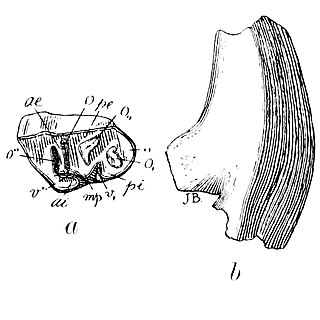
Homidia is a genus of springtails belonging to the family Entomobryidae. Species include:
Homidia pentachaeta is a species of soil-dwelling springtail belonging to the family Entomobryidae. It is only known from its type location in the vicinity of Nanjing, People's Republic of China.

The Cingulopsoidea is a superfamily of sea snails, marine gastropod molluscs in the clade Littorinimorpha.

Cingulopsidae is a family of sea snails, marine gastropod molluscs in the clade Littorinimorpha.

Cingula trifasciata is a species of sea snail, a marine gastropod mollusk or micromollusk in the family Rissoidae.

Cingula is a genus of minute sea snails, marine gastropod mollusks or micromollusks in the family Rissoidae.
Homidia anhuiensis is a species of slender springtail in the family Entomobryidae.
Homidia formosana is a species of slender springtail in the family Entomobryidae.
Homidia laha is a species of slender springtail in the family Entomobryidae.
Homidia latifolia is a species of slender springtail in the family Entomobryidae.
Homidia nigrocephala is a species of slender springtail in the family Entomobryidae.
Homidia phjongjangica is a species of slender springtail in the family Entomobryidae.
Homidia similis is a species of slender springtail in the family Entomobryidae.
Homidia sinensis is a species of slender springtail in the family Entomobryidae.

Homidia socia is a species of slender springtail in the family Entomobryidae.
Homidia subcingula is a species of slender springtail in the family Entomobryidae.
Homidia tiantaiensis is a species of slender springtail in the family Entomobryidae. It can be found in China. It has been known to feed on Pleurotus ostreatus.
Watutia is an extinct genus of fossil kangaroo known from the Pliocene from New Guinea. It is only known from the type species Watutia novaeguineae, known from some fragmentary upper and lower jaws and isolated teeth from the Pliocene Otibanda Formation in the Morobe Province of Papua New Guinea. The closest relative of the genus was possibly Hadronomas, who lived in today's Queensland a few million years earlier. W. novaeguineae was about the size of a large shrub wallaby (Dorcopsis) and differs in some characteristics from the teeth of other kangaroos. The molars were low and the first premolars elongated. Cristids obliqua and posterior cingula are missing on the lower molars. The feature that defines the close association with Hadronomas was the upper first premolar, which was more bulbous with no lingual cingulum, differing it from most Macropods.

Argyrohippus is an extinct genus of notoungulate, belonging to the family Notohippidae. It lived from the Late Oligocene to the Early Miocene, and its fossilized remains were found in South America.
Moqueguahippus is an extinct genus of notohippid notoungulates that lived during the Late Oligocene of what is now Peru. Fossils of this genus have been found in the Moquegua Formation of Peru, which it was named after.



